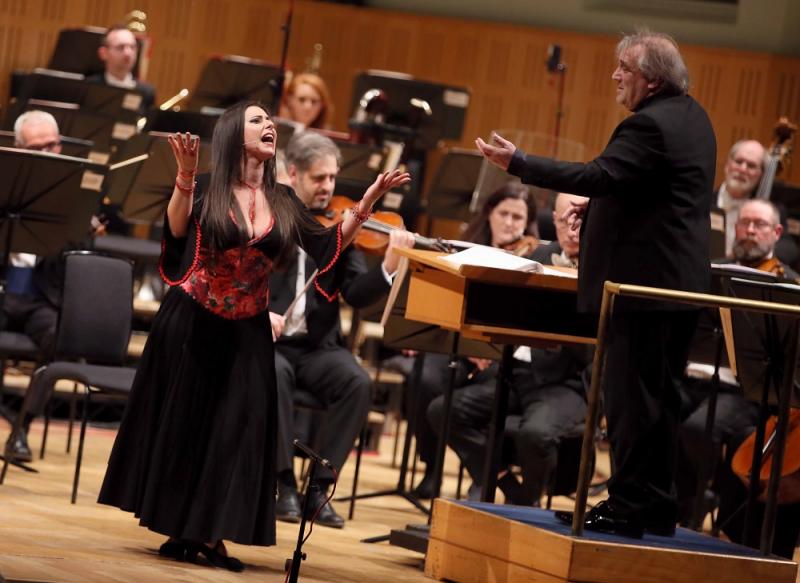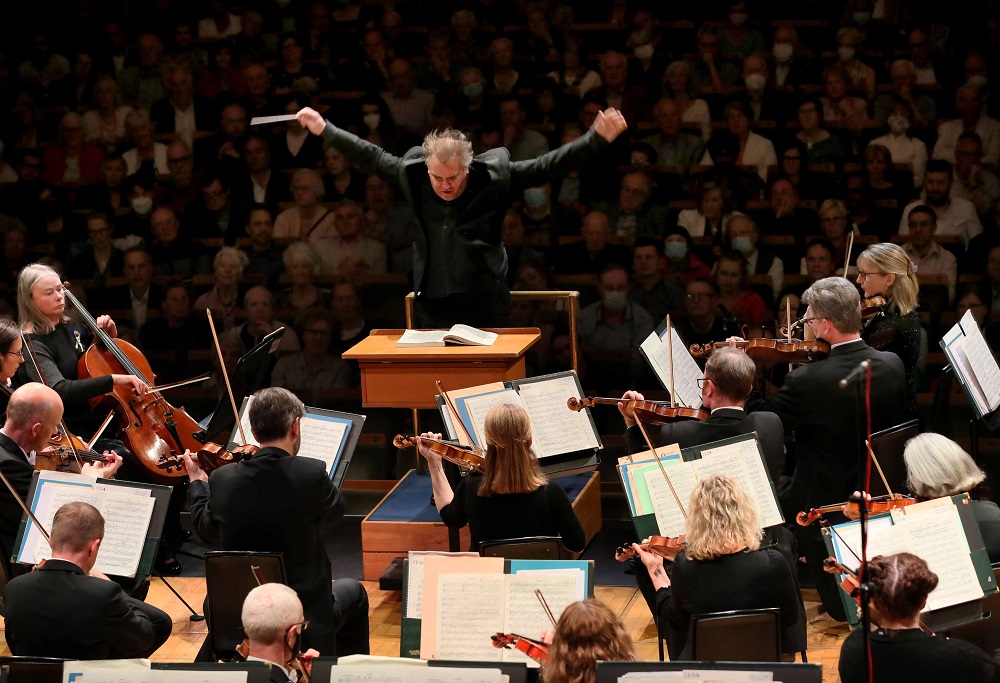Sánchez, National Symphony Orchestra, Martín, National Concert Hall, Dublin review - Spanish panache | reviews, news & interviews
Sánchez, National Symphony Orchestra, Martín, National Concert Hall, Dublin review - Spanish panache
Sánchez, National Symphony Orchestra, Martín, National Concert Hall, Dublin review - Spanish panache
Flamenco song and dance matched to orchestral brilliance brings heat to a freezing city

Ravel’s Boléro, however well you think you know it, usually wows in concert with its disconcerting mix of sensuality, fun and violence. Context can make it even more powerful: in this case as the culmination of NSO Chief Conductor Jaime Martín’s brilliantly programmed Spanish fiesta, a cool and even customer at first after chameleonic Chabrier and fidgety-brilliant, fluid Falla.
The special guest was well known to many Dubliners. During lockdown, the orchestra’s programming of Falla’s El amor brujo (Love the Magician) came up against the 14-day quarantine rule for visiting musicians. Seville-born and flamenco-trained Rebecca Sánchez was working in a care home in Belturbet, County Cavan. Performing in a hall with orchestra but without an audience, she caused a sensation on the RTÉ Lyric broadcast. And righty so: such charm, beaming at the orchestra even when she wasn’t singing or dancing, and totally professional in the delivery of the cantaora’s role.
Since this was the original 1915 Gitaneria rather than the 1924 Ballet pantomimico, we also got the melodrama of the spells spoken by protagonist Candela to exorcise the persistent spirit of her dead husband. It would have been good to get the translations in programme or supertitles, but Sánchez is such a live-wire performer that the message got across.  The rapier thrust of Falla’s score, trumpet-led, came as an incisive contrast to the big glitter of Chabrier’s España, a curtain-raiser of masterly orchestration which put a sizeable audience in a good mood – further enhanced by Martín’s very likeable spiel as the platform was rearranged (the conductor with the orchestra pictured above by Stedman Photography). As well as offering a heartfelt tribute to Sánchez, he told us that he’s from Santander, where it always rains – not so different from Dublin – so wasn’t brought up in the fiery tradition of Andalusian flamenco. But his mix of focus and freedom did the trick, and explained why he’s such a popular figure in Ireland.
The rapier thrust of Falla’s score, trumpet-led, came as an incisive contrast to the big glitter of Chabrier’s España, a curtain-raiser of masterly orchestration which put a sizeable audience in a good mood – further enhanced by Martín’s very likeable spiel as the platform was rearranged (the conductor with the orchestra pictured above by Stedman Photography). As well as offering a heartfelt tribute to Sánchez, he told us that he’s from Santander, where it always rains – not so different from Dublin – so wasn’t brought up in the fiery tradition of Andalusian flamenco. But his mix of focus and freedom did the trick, and explained why he’s such a popular figure in Ireland.
Standing (“Dublin”) ovations came not only after El amor brujo but also at the end of the two suites from El sombrero de tres picos (The Three-Cornered Hat). And no wonder: the zany finale at the end of the second suite turns the screw on a ferocity which flared in this performance from the Miller’s Dance onwards. Colours throughout were fine-tuned, and it was the bassoons’ night, both collectively and individually, from España through to the moment in the sun in Boléro. There’s something oddly moving about Ravel’s woodwind solos in the early stages, at least in this performance when a certain restraint brought tears to the eyes. Percussionist Rebecca Celebuski, whose xylophone work in the previous work resounded with a special edge, was compellingly unflappable in that insanely demanding non-stop side-drum tattoo, and Martin’s urging of energy in the later stages showed us why a physically demonstrative conductor is so important in a work which might not seem to need one. Simply glorious.
- Listen to this concert on RTE lyric fm. Concert starts at 30m30s
- More classical reviews on theartsdesk
Watch a short film on Sánchez's first Falla with the NSO
The future of Arts Journalism
You can stop theartsdesk.com closing!
We urgently need financing to survive. Our fundraising drive has thus far raised £49,000 but we need to reach £100,000 or we will be forced to close. Please contribute here: https://gofund.me/c3f6033d
And if you can forward this information to anyone who might assist, we’d be grateful.

Subscribe to theartsdesk.com
Thank you for continuing to read our work on theartsdesk.com. For unlimited access to every article in its entirety, including our archive of more than 15,000 pieces, we're asking for £5 per month or £40 per year. We feel it's a very good deal, and hope you do too.
To take a subscription now simply click here.
And if you're looking for that extra gift for a friend or family member, why not treat them to a theartsdesk.com gift subscription?
more Classical music
 Hallé John Adams festival, Bridgewater Hall / RNCM, Manchester review - standing ovations for today's music
From 1980 to 2025 with the West Coast’s pied piper and his eager following
Hallé John Adams festival, Bridgewater Hall / RNCM, Manchester review - standing ovations for today's music
From 1980 to 2025 with the West Coast’s pied piper and his eager following
 Kaploukhii, Greenwich Chamber Orchestra, Cutts, St James's Piccadilly review - promising young pianist
A robust and assertive Beethoven concerto suggests a player to follow
Kaploukhii, Greenwich Chamber Orchestra, Cutts, St James's Piccadilly review - promising young pianist
A robust and assertive Beethoven concerto suggests a player to follow
 Robin Holloway: Music's Odyssey review - lessons in composition
Broad and idiosyncratic survey of classical music is insightful but slightly indigestible
Robin Holloway: Music's Odyssey review - lessons in composition
Broad and idiosyncratic survey of classical music is insightful but slightly indigestible
 Classical CDs: Wolf-pelts, clowns and social realism
British ballet scores, 19th century cello works and contemporary piano etudes
Classical CDs: Wolf-pelts, clowns and social realism
British ballet scores, 19th century cello works and contemporary piano etudes
 Bizet in 150th anniversary year: rich and rare French offerings from Palazzetto Bru Zane
Specialists in French romantic music unveil a treasure trove both live and on disc
Bizet in 150th anniversary year: rich and rare French offerings from Palazzetto Bru Zane
Specialists in French romantic music unveil a treasure trove both live and on disc
 Scottish Chamber Orchestra, Ibragimova, Queen’s Hall, Edinburgh review - rarities, novelties and drumrolls
A pity the SCO didn't pick a better showcase for a shining guest artist
Scottish Chamber Orchestra, Ibragimova, Queen’s Hall, Edinburgh review - rarities, novelties and drumrolls
A pity the SCO didn't pick a better showcase for a shining guest artist
 Kilsby, Parkes, Sinfonia of London, Wilson, Barbican review - string things zing and sing in expert hands
British masterpieces for strings plus other-worldly tenor and horn - and a muscular rarity
Kilsby, Parkes, Sinfonia of London, Wilson, Barbican review - string things zing and sing in expert hands
British masterpieces for strings plus other-worldly tenor and horn - and a muscular rarity
 From Historical to Hip-Hop, Classically Black Music Festival, Kings Place review - a cluster of impressive stars for the future
From quasi-Mozartian elegance to the gritty humour of a kitchen inspection
From Historical to Hip-Hop, Classically Black Music Festival, Kings Place review - a cluster of impressive stars for the future
From quasi-Mozartian elegance to the gritty humour of a kitchen inspection
 Shibe, LSO, Adès, Barbican review - gaudy and glorious new music alongside serene Sibelius
Adès’s passion makes persuasive case for the music he loves, both new and old
Shibe, LSO, Adès, Barbican review - gaudy and glorious new music alongside serene Sibelius
Adès’s passion makes persuasive case for the music he loves, both new and old
 Anja Mittermüller, Richard Fu, Wigmore Hall review - a glorious hall debut
The Austrian mezzo shines - at the age of 22
Anja Mittermüller, Richard Fu, Wigmore Hall review - a glorious hall debut
The Austrian mezzo shines - at the age of 22
 First Person: clarinettist Oliver Pashley on the new horizons of The Hermes Experiment's latest album
Compositions by members of this unusual quartet feature for the first time
First Person: clarinettist Oliver Pashley on the new horizons of The Hermes Experiment's latest album
Compositions by members of this unusual quartet feature for the first time

Add comment